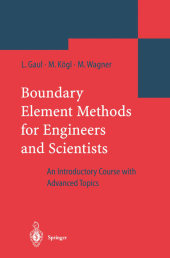 Neuerscheinungen 2012Stand: 2020-01-07 |
Schnellsuche
ISBN/Stichwort/Autor
|
Herderstraße 10
10625 Berlin
Tel.: 030 315 714 16
Fax 030 315 714 14
info@buchspektrum.de |

Lothar Gaul, Martin Kögl, Marcus Wagner
(Beteiligte)
Boundary Element Methods for Engineers and Scientists
An Introductory Course with Advanced Topics
Softcover reprint of the original 1st ed. 2003. 2012. xv, 488 S. 145 SW-Abb. 235 mm
Verlag/Jahr: SPRINGER, BERLIN 2012
ISBN: 3-642-05589-3 (3642055893)
Neue ISBN: 978-3-642-05589-8 (9783642055898)
Preis und Lieferzeit: Bitte klicken
Over the past decades, the Boundary Element Method has emerged as a ver satile and powerful tool for the solution of engineering problems, presenting in many cases an alternative to the more widely used Finite Element Method. As with any numerical method, the engineer or scientist who applies it to a practical problem needs to be acquainted with, and understand, its basic principles to be able to apply it correctly and be aware of its limitations. It is with this intention that we have endeavoured to write this book: to give the student or practitioner an easy-to-understand introductory course to the method so as to enable him or her to apply it judiciously. As the title suggests, this book not only serves as an introductory course, but also cov ers some advanced topics that we consider important for the researcher who needs to be up-to-date with new developments. This book is the result of our teaching experiences with the Boundary Element Method, along with research and consulting activities carried out in the field. Its roots lie in a graduate course on the Boundary Element Method given by the authors at the university of Stuttgart. The experiences gained from teaching and the remarks and questions of the students have contributed to shaping the ´Introductory course´ (Chapters 1-8) to the needs of the stu dents without assuming a background in numerical methods in general or the Boundary Element Method in particular.
Introduction.- Mathematical Preliminaries.- Continuum Physics.- Boundary Element Method for Potential Problems.- Boundary Element Method for Elastic Continua.- Numerical Integration.- DRM for Potential Problems and Elastodynamics.- Solution of the Equations of Motion.- Dynamic Piezoelectricity.- Coupled Thermoelasticity.- Variational Principles of Continuum Mechanics.- The Hybrid Displacement Method.- The Hybrid Stress Method for Acoustics.- The Hybrid Boundary Element Method in Time Domain.- Properties of Elastic Materials.- Fundamental Solutions.- Particular Solutions.- The Bott-Duffin Inverse.
From the reviews of the first edition:
"The textbook can be recommended strongly to graduate students as well as to researchers working in the field of Boundary Element Methods. Since the basic mathematical and physical knowledge needed to understand the methodology is given at the beginning of the book ... the book can be either used for self-study or as the basis for a university course. Researchers who need to learn more about extensions and alternative approaches to the classical BEM certainly will appreciate the second and third parts of the book." (O. von Estorff, ZAMM - Zeitschrift für Angewandte Mathematik und Mechanik, Vol. 85 (10), 2005)
"Over the past decades, the boundary element method has emerged as a versatile and powerful tool for the solution of engineering problems, presenting in many cases an alternative to the more widely used finite element method. As with any numerical method, the engineer or scientist who applies it to a practical problem needs to be acquainted with, and understand, its basic principles to be able to apply it correctly and be aware of its limitations. The present book is very helpful in this direction." (Ján Sládek, Zentralblatt MATH, Vol. 1071, 2005)


